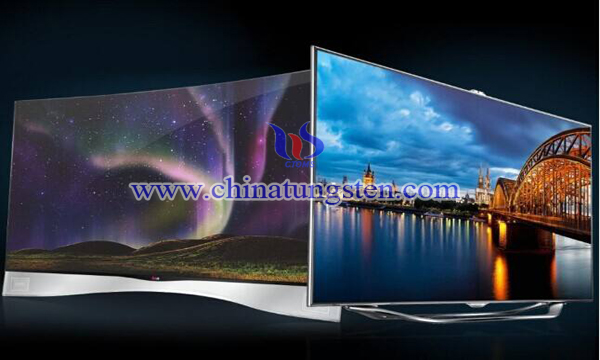Tungsten Trioxide Application in OLED
- Details
- Category: Tungsten Information
- Published on Saturday, 16 December 2017 12:59
The luminescence of OLED belongs to the laser luminescence. Laser luminescence can be divided into two kinds. One is a thin film laser light emitting plate (TFEL) made from element periodic table elements. The other is a light-emitting diode (LED) made of inorganic P and N type semiconductors.

These are the two kinds of LCD panels we use today, the LCD (TF) and the LED screens. The TF screen has a slow response and needs a few hundred volts of AC voltage, so the fuselage is thicker and less energy saving, and it has been phased out. LED screen has high brightness, wide visual angle, good display effect and energy saving, which has become the mainstream. Early LED difficult to achieve large screen production and it has been suppressed by the LCD screen until technology improvement.
The improvement of this new technology is a very thin film of insulation on the LED positive ITO, also known as the buffer layer. The energy level matching between the anode and the cavity transport layer is adjusted in order to improve the hole injection efficiency and reduce the driving voltage. ITO used as the anode, and between ITO and NPB layer is inserted into the tungsten oxide as a buffer layer.
Tungsten oxide semiconductor thin films were prepared by DC magnetron sputtering and pulsed plasma deposition method (PPD) on glass substrates. The target respectively is 99.99% pure tungsten metal target and tungsten trioxide powder pressing and sintering of tungsten oxide target. Analysis by XRD and AFM characterization of lattice structure and surface morphology of tungsten oxide films, experiments show that the prepared tungsten oxide is amorphous, with a relatively smooth surface.
The study found: tungsten oxide buffer layer OLED devices fabricated by magnetron sputtering: When the working voltage is 20V. The luminance of ITO-OLED is 8791cd/m2, The luminance of ITO/WO3-OLED brightness is 16690cd/m2. When the voltage is added to 19V, the power efficiency of the ITO/WO3-OLED device reaches the maximum value of 1.581m/W. When the voltage is added to 20V, the power efficiency of the ITO-OLED device reaches the maximum value of 0.76lm/W, and the value is the former 1/2. For ITO-OLED devices, when the current density increases, the luminous efficiency increases. When the current density reaches 181.9mA/cm2, the luminous efficiency reaches the maximum value of 4.83cd/A.
Research shows that the OLED device by adding tungsten oxide buffer layer effectively improves the brightness. At the same time, the power efficiency is due to tungsten trioxide insertion has been effectively improved, the main reason is that the work function of tungsten oxide modified layer is helpful to improve the performance of OLED devices.
- Tungsten Oxide Manufacturer & Supplier, Chinatungsten Online: www.tungsten-oxide.com
- Tungsten News & Prices of China Tungsten Industry Association: www.ctia.com.cn
- Molybdenum News & Price: news.molybdenum.com.cn
- Tel.: 86 592 5129696; Fax: 86 592 5129797; Email: sales@chinatungsten.com



 sales@chinatungsten.com
sales@chinatungsten.com